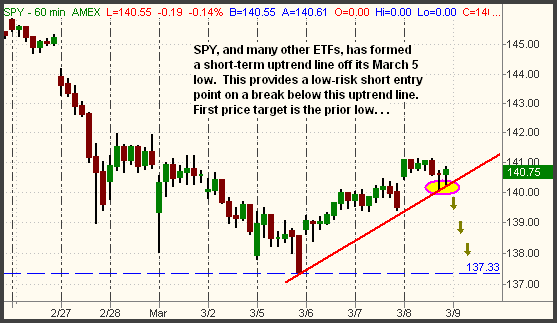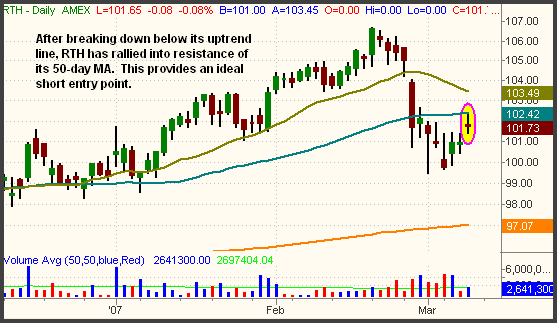| The Wagner Daily ETF Report for March 9 |
| By Deron Wagner |
Published
03/9/2007
|
Stocks
|
Unrated
|
|
|
|
The Wagner Daily ETF Report for March 9
Stocks gapped sharply higher and trended sideways throughout most of the day, but another afternoon sell-off caused the major indices to give up a lot of their earlier gains. The S&P 500, small-cap Russell 2000, and S&P Midcap 400 indices each advanced 0.7%, while both the Nasdaq Composite and Dow Jones Industrial Average rallied 0.6%. Though the Nasdaq finished with a 0.6% gain, it was trading 1.1% higher at its mid-day high. The S&P and Dow both finished in the middle of their intraday ranges, but the Nasdaq closed in the bottom third of its range.
Unfortunately for the bulls, volume in both exchanges fell again. Total volume in the NYSE declined by 5%, while volume in the Nasdaq was 2% lower than the previous day's level. Since putting in a short-term bottom on March 5, the major indices have trended steadily higher off their lows, but volume has dropped in each of the past three sessions. As stock prices have increased, institutions have shown decreasing buying interest each day. It is dangerous when stocks trend higher on continually decreasing volume because it only takes one volume of higher volume selling to erase several such days of gains.
Yesterday, the S&P 500 moved above its 23.6% Fibonacci retracement to touch resistance of its 38.2% retracement at the 1,407 level, but the index closed six points below it. The Nasdaq Composite showed relative weakness and only rallied above its 23.6% retracement by a small margin. Since forming its short-term low on March 5, the S&P has trended higher in each of the past three days and has also retraced just over one-third of its loss from the February 22 high. The move has been substantial enough to be labeled as a solid bounce, and has also caused a clearly defined short-term uptrend channel to be formed. To illustrate this, take a look at the hourly chart of the S&P 500 SPDR (SPY). The ascending red line marks the lower channel support of the short-term uptrend line that has formed:

Given that the rise off the lows has been on successively lighter volume and the 38.2% retracement has already been tested, we feel there is a good chance SPY will break below the newly formed short-term uptrend line within the next day or two. If it does, SPY could suffer a rapid move back down to test the prior low of March 5. As such, SPY has set up for a low-risk short sale entry if it breaks below the hourly uptrend line. For better confirmation, you could wait for a break of yesterday's low, just below the uptrend line. If you prefer the inversely correlated ProShares ETFs, simply buy above the hourly downtrend line or over yesterday's high. The other major indices such as the Nasdaq and Dow have formed similar chart patterns as well, so take your pick.
Selling short a break of the hourly uptrend lines is a good strategy, but it's even better when the 50-day moving average is also providing resistance just overhead. With the major indices, their 50-day MAs are still well above their current prices, but a few of the industry sector ETFs ran into their 50-day MAs yesterday. Remember that prior support becomes new resistance after the support is broken, so a rally into a 50-day MA provides solid resistance. One ETF with such a chart pattern is the Retail HOLDR (RTH). Not only has a short-term uptrend line formed off the March 5 low, but the 50-day MA is acting as resistance just over yesterday's high:

Like the SPY, a break below yesterday's low in RTH presents an ideal short entry with a positive risk/reward ratio. Simply place your protective stop just above the 50-day moving average, while shooting for a downside profit target of at least the March 5 low.
Obviously, the major indices could stage a rally attempt to their 50% retracement levels before moving lower, but there's no harm done if they do. If you're not already short, simply wait for confirmation of the uptrend line breaks. If you're already short and can't take any more pain of a further bounce, just close the position and wait for a re-entry below its uptrend line. Regardless of how long it takes, the key point is that markets very rarely recover from a sell-off of last week's intensity only a week or two later. Generally, it takes at least two or three months to begin seeing signs of institutional accumulation once again.
Deron Wagner is the Founder and Head Trader of both Morpheus Capital LP, a U.S. hedge fund, and Morpheus Trading Group, a trader education firm launched in 2001 that provides daily technical analysis of the leading ETFs and stocks. For a free trial to the full version of The Wagner Daily or to learn about Wagner's other services, visit MorpheusTrading.com or send an e-mail to deron@morpheustrading.com.
|